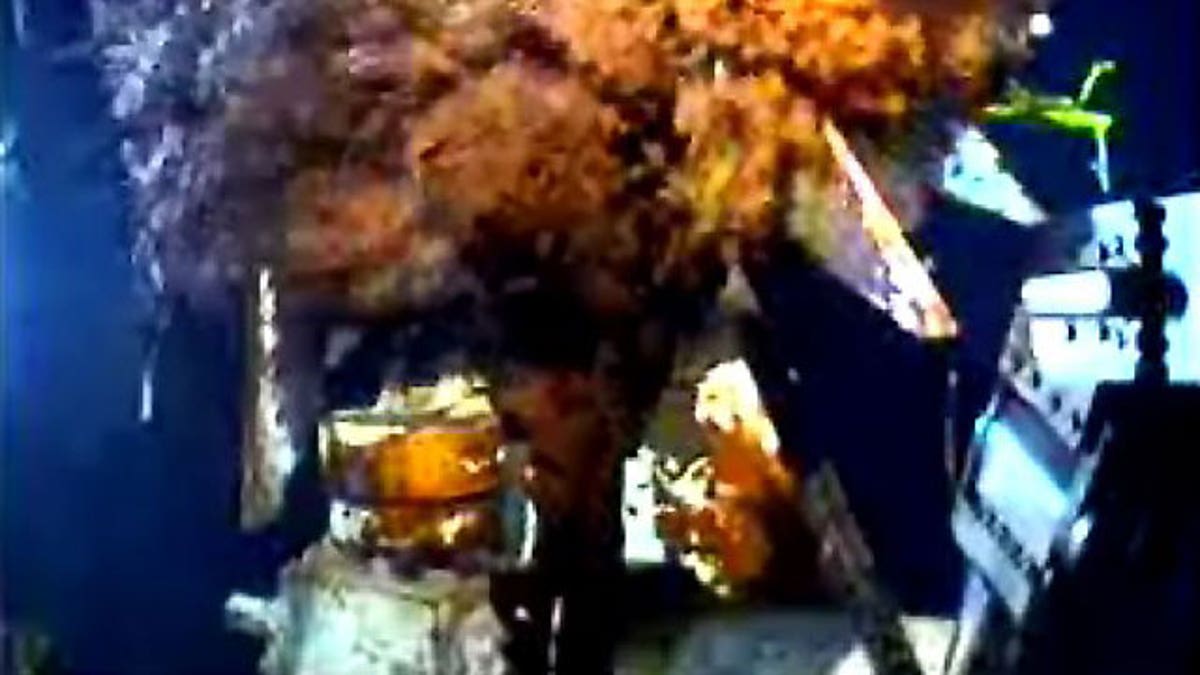
June 23, 2010: This image from video provided by BP shows oil gushing from the broken wellhead at the site of the Deepwater Horizon oil well in the Gulf of Mexico. (AP)
BP officials on Friday left open the door to someday drilling again into the same lucrative undersea pocket of oil that spilled millions of gallons of crude, wrecked livelihoods and fouled beaches along the Gulf of Mexico -- and, for now, the Obama administration isn't shooting the idea down either.
The Interior Department would only go as far as to say that BP wouldn't regain access to the now-capped well that began gushing oil after the deadly April 20 explosion at a company-run rig off Louisiana.
"The well is almost dead. Under no circumstances are we going to allow them to reopen the well to extract oil and gas from the Macondo well," Interior spokeswoman Kendra Barkoff told FoxNews.com.
But BP may be interested in the vast oil reservoir beneath the blown well that is still believed to hold nearly $4 billion worth of crude. With the company and its partners facing tens of billions of dollars in liabilities, the incentive to exploit the wells and the reservoir could grow.
"There's lots of oil and gas here," Chief Operating Officer Doug Suttles said at a news briefing Friday when asked about the possibility. "We're going to have to think about what to do with that at some point."
BP spokesman Daren Beaudo emphasized to FoxNews.com that the company has no plans to develop the reservoir.
"We're focused 100 percent on the job at hand, which is killing the well, cleaning up the oil and restoring the Gulf Coast economy," he said.
Retired Coast Guard Adm. Thad Allen, the government's point man on the spill, said he had no information on BP's future plans.
"I would assume that's a policy issue related to the management of the lease," he told reporters. "Frankly, it hasn't been raised to my level at this point. I'm not sure I can comment on it."
A senior official with the Interior Department told FoxNews.com that the agency has had no communications with BP about drilling in the reservoir.
"It is too premature to talk or even speculate about them drilling there," the official said.
Suttles has spent more than three months managing BP's response efforts on the Gulf but is now returning to his day job in Houston, the company said. Mike Utsler, a vice president who has been running BP's command post in Houma, La., since April, will replace him.
The personnel shift comes as BP appears to be gaining the upper hand on plugging the leak.
Engineers this week poured in cement to complete a plug at the top of the well bore as part of a process dubbed a "static kill," but they needed to wait at least a day for the cement to harden. Once it does, crews can finish the last stretch of a relief well intersecting the blown well just above the oil's source, injecting more mud and cement from the bottom to form a final plug.
Suttles confirmed Friday that crews for now plan to use the 18,000-foot relief well to seal off with mud and cement the underground reservoir feeding the blown well.
The company had been hedging on how exactly it would use the relief well, which it has been digging for three months, as federal officials insisted it should be used to perform the so-called "bottom kill."
If not used for the bottom kill, the relief wells could have conceivably offered a way for BP or another company to pump oil from the reservoir and sell it, an idea unlikely to sit well with Gulf Coast residents and families of workers who died on the rig.
The static kill started Tuesday with engineers pumping enough mud down the top of the well to push the crude back to its underground source. Suttles said engineers plan to monitor the cement newly pumped in from the top and test the plug to make sure it's sealed.
"All the indications so far look very encouraging," he said.
A federal report this week indicated that only about a quarter of the spilled crude remains in the Gulf and is degrading quickly.
"There's essentially no skimmable oil left on the surface, no recoverable oil left on the surface," Suttles said.
Some scientists disputed the report's veracity, and much of the remaining crude has permeated deep into marshes and wetlands, complicating cleanup.
BP had 31,000 workers along the Gulf on Friday, down from 48,000 at the height of the response, Suttles said.
As BP pulled brought in 33-year employee Utsler to take over the response and the blown well appeared to have flatlined, some Gulf residents who still see the oil wreaking havoc worried the nation's attention was shifting.
Utsler told them not to worry, saying the spill's effects are "a challenge that we continue to recognize with more than 20,000-plus people continuing to work."
Willie Davis, a 41-year-old harbormaster in Pass Christian, Miss., feared his area would be forgotten if BP pulls out too soon.
"I'm losing trust in the whole system," Davis said. "If they don't get up off their behinds and do something now, it's gonna be years before we're back whole again."
The Associated Press contributed to this report.




